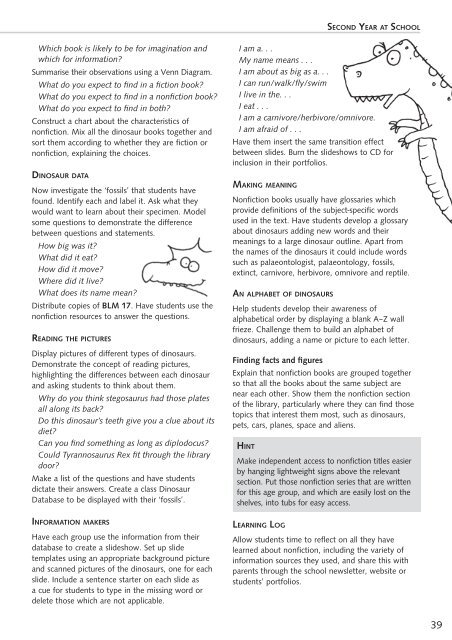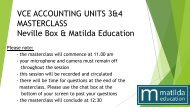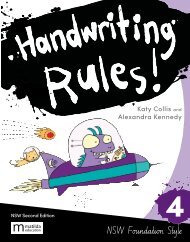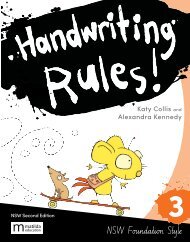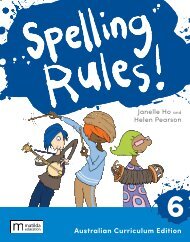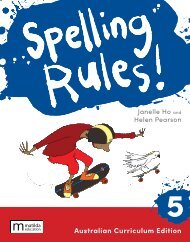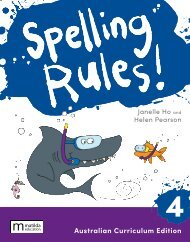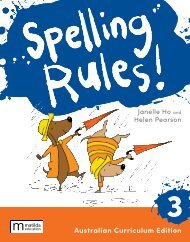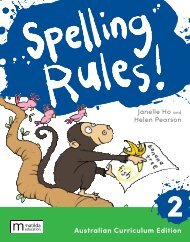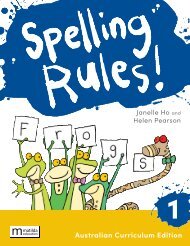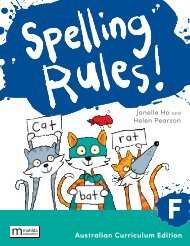All You Need to Teach - Info Literacy 5-8
Create successful ePaper yourself
Turn your PDF publications into a flip-book with our unique Google optimized e-Paper software.
Second Year at School<br />
Which book is likely <strong>to</strong> be for imagination and<br />
which for information?<br />
Summarise their observations using a Venn Diagram.<br />
What do you expect <strong>to</strong> find in a fiction book?<br />
What do you expect <strong>to</strong> find in a nonfiction book?<br />
What do you expect <strong>to</strong> find in both?<br />
Construct a chart about the characteristics of<br />
nonfiction. Mix all the dinosaur books <strong>to</strong>gether and<br />
sort them according <strong>to</strong> whether they are fiction or<br />
nonfiction, explaining the choices.<br />
Dinosaur data<br />
Now investigate the ‘fossils’ that students have<br />
found. Identify each and label it. Ask what they<br />
would want <strong>to</strong> learn about their specimen. Model<br />
some questions <strong>to</strong> demonstrate the difference<br />
between questions and statements.<br />
How big was it?<br />
What did it eat?<br />
How did it move?<br />
Where did it live?<br />
What does its name mean?<br />
Distribute copies of BLM 17. Have students use the<br />
nonfiction resources <strong>to</strong> answer the questions.<br />
Reading the pictures<br />
Display pictures of different types of dinosaurs.<br />
Demonstrate the concept of reading pictures,<br />
highlighting the differences between each dinosaur<br />
and asking students <strong>to</strong> think about them.<br />
Why do you think stegosaurus had those plates<br />
all along its back?<br />
Do this dinosaur’s teeth give you a clue about its<br />
diet?<br />
Can you find something as long as diplodocus?<br />
Could Tyrannosaurus Rex fit through the library<br />
door?<br />
Make a list of the questions and have students<br />
dictate their answers. Create a class Dinosaur<br />
Database <strong>to</strong> be displayed with their ‘fossils’.<br />
<strong>Info</strong>rmation makers<br />
Have each group use the information from their<br />
database <strong>to</strong> create a slideshow. Set up slide<br />
templates using an appropriate background picture<br />
and scanned pictures of the dinosaurs, one for each<br />
slide. Include a sentence starter on each slide as<br />
a cue for students <strong>to</strong> type in the missing word or<br />
delete those which are not applicable.<br />
I am a. . .<br />
My name means . . .<br />
I am about as big as a. . .<br />
I can run/walk/fly/swim<br />
I live in the. . .<br />
I eat . . .<br />
I am a carnivore/herbivore/omnivore.<br />
I am afraid of . . .<br />
Have them insert the same transition effect<br />
between slides. Burn the slideshows <strong>to</strong> CD for<br />
inclusion in their portfolios.<br />
Making meaning<br />
Nonfiction books usually have glossaries which<br />
provide definitions of the subject-specific words<br />
used in the text. Have students develop a glossary<br />
about dinosaurs adding new words and their<br />
meanings <strong>to</strong> a large dinosaur outline. Apart from<br />
the names of the dinosaurs it could include words<br />
such as palaeon<strong>to</strong>logist, palaeon<strong>to</strong>logy, fossils,<br />
extinct, carnivore, herbivore, omnivore and reptile.<br />
An alphabet of dinosaurs<br />
Help students develop their awareness of<br />
alphabetical order by displaying a blank A–Z wall<br />
frieze. Challenge them <strong>to</strong> build an alphabet of<br />
dinosaurs, adding a name or picture <strong>to</strong> each letter.<br />
Finding facts and figures<br />
Explain that nonfiction books are grouped <strong>to</strong>gether<br />
so that all the books about the same subject are<br />
near each other. Show them the nonfiction section<br />
of the library, particularly where they can find those<br />
<strong>to</strong>pics that interest them most, such as dinosaurs,<br />
pets, cars, planes, space and aliens.<br />
Hint<br />
Make independent access <strong>to</strong> nonfiction titles easier<br />
by hanging lightweight signs above the relevant<br />
section. Put those nonfiction series that are written<br />
for this age group, and which are easily lost on the<br />
shelves, in<strong>to</strong> tubs for easy access.<br />
Learning Log<br />
<strong>All</strong>ow students time <strong>to</strong> reflect on all they have<br />
learned about nonfiction, including the variety of<br />
information sources they used, and share this with<br />
parents through the school newsletter, website or<br />
students’ portfolios.<br />
39


